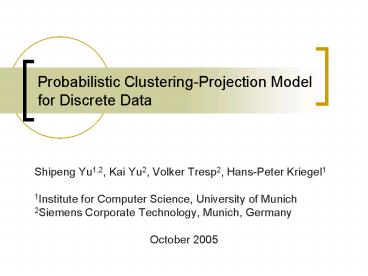Probabilistic Clustering-Projection Model for Discrete Data - PowerPoint PPT Presentation
Title:
Probabilistic Clustering-Projection Model for Discrete Data
Description:
1Institute for Computer Science, ... Bike. Baseball. Hockey. 18. Exp1: Document Modelling. Goal: Evaluate generalization performance. Methods to compare ... – PowerPoint PPT presentation
Number of Views:34
Avg rating:3.0/5.0
Title: Probabilistic Clustering-Projection Model for Discrete Data
1
Probabilistic Clustering-Projection Model for
Discrete Data
- Shipeng Yu1,2, Kai Yu2, Volker Tresp2, Hans-Peter
Kriegel1 - 1Institute for Computer Science, University of
Munich - 2Siemens Corporate Technology, Munich, Germany
- October 2005
2
Outline
- Motivation
- Previous Work
- The PCP Model
- Learning in PCP Model
- Experiments
- Conclusion and Future Work
3
Motivation
- We model discrete data in this work
- Fundamental problem for data mining and machine
learning - In bag-of-words document modelling
document-word pairs - In collaborative filtering item-rating pairs
- Properties
- The data can be described as a big matrix with
integer entries - The data matrix is normally very sparse (gt90 are
zeros)
Occurrences
4
Data Clustering
- Goal Group similar documents together
- For continuous data Distance-based similarity
(k-means) - Iteratively minimize a distance-based cost
function - Equivalent to a Gaussian mixture model
- For discrete data Occurrence-based similarity
- Similar documents should have similar occurrences
of words - No Gaussianity holds for discrete data
5
Data Projection
- Goal Find a low-dimensional feature mapping
- For continuous data Principal Component Analysis
- Find orthogonal dimensions to explain data
covariance - For discrete data Topic detection
- Topics explain the co-occurrences of words
- Topics are not orthogonal, but independent
6
Projection versus Clustering
- They are normally modelled separately
- But why not jointly?
- More informative projection ?
- better document clusters
- Better clustering structure ?
- better projection for words
- There should be a stable situation
- And how? PCP Model
- Well-defined generative model for the data
- Standard ways for learning and inference
- Generalizable to new data
7
Previous Work for Discrete Data
Projection model
Clustering model
- PLSI Hofmann 99
- First topic model
- Not well-defined generative model
- LDA Blei et al 03
- State-of-the-art topic model
- Generalize PLSI with Dirichlet prior
- No clustering effect is modelled
- NMF Lee Seung 99
- Factorize the data matrix
- Can be explained as a clustering model
- No projection of words is directly modelled
Joint Projection-Clustering model
- Two-sided clustering Hofmann Puzicha 98 Same
problem as PLSI - Discrete-PCA Buntine Perttu 03 Similar to
LDA in spirit - TTMM Keller Bengio 04 Lack a full Bayesian
explanation
8
PCP Model Overview
- Probabilistic Clustering-Projection Model
- A probabilistic model for discrete data
- A clustering model using projected features
- A projection model with structural data
- Learning in PCP model Variational EM
- Exactly equivalent to iteratively performing
clustering and projection operations - Guaranteed convergence
9
PCP Model Sampling Process
Multinomial
Multinomial
Dirichlet
Multinomial
...
...
...
...
Dirichlet
V words
D documents
M clusters
K topics
Clustering model using projected features
Projection model with structural data
10
PCP Model Plate Model
Model Parameters
- Likelihood
Latent Variables
Observations
11
Learning in PCP Model
- We are interested in the posterior distribution
- The integral is intractable
- Variational EM learning
- Approximate the posterior with a variational
distribution - Minimize the KL-divergence
- Variational E-step Minimize w.r.t. variational
parameters - Variational M-step Minimize w.r.t. model
parameters - Iterate until convergence
Variational Parameters
Dirichlet
Dirichlet
Multinomial
Multinomial
12
Update Equations
- Equations can be separated to clustering updates
and projection updates - Variational EM learning corresponds to
iteratively performing clustering and projection
until convergence
Clustering Updates
Projection Updates
13
Clustering Updates
Update cluster centers
Update cluster weights
14
Projection Updates
Update projection matrix
15
PCP Learning Algorithm
Clustering Updates
Projection Updates
16
Experiments
- Methodology
- Document Modelling Compare model generalization
- Word Projection Evaluate topic space
- Document Clustering Evaluate clustering results
- Data sets
- 5 categories in Reuters-21578 3948 docs, 7665
words - 4 categories in 20Newsgroup 3888 docs, 8396
words - Preprocessing
- Stemming and stop-word removing
- Pick up words that occur at least in 5 documents
17
Case Study
- Run on a 4-group subset of 20Newsgroup data
18
Exp1 Document Modelling
- Goal Evaluate generalization performance
- Methods to compare
- PLSI A pseudo form for generalization
- LDA State-of-the-art method
- Metric Perplexity
- 90 for training and 10 for testing
19
Exp2 Word Projection
- Goal Evaluate the projection matrix
- Methods to compare PLSI, LDA
- We train SVMs on the 10-dimensional space after
projection - Test classification accuracy on leave-out data
Reuters
Newsgroup
20
Exp3 Document Clustering
- Goal Evaluate clustering for documents
- Methods to compare
- NMF Do factorization for clustering
- LDAk-means Do clustering on the projected space
- Metric normalized mutual information
21
Conclusion
- PCP is a well-defined generative model
- PCP models clustering and projection jointly
- Learning in PCP corresponds to an iterative
process of clustering and projection - PCP learning guarantees convergence
- Future work
- Large scale experiments
- Build a probabilistic model with more factors
22
Thank you!
- Questions?































